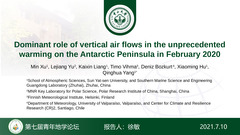Dominant role of vertical air flows in the unprecedented warming on the Antarctic Peninsula in February 2020
编号:1719
稿件编号:357 访问权限:仅限参会人
更新:2021-06-16 14:30:59 浏览:1432次
口头报告
摘要
Near-surface air temperature at the Argentinian research base Esperanza on the northern tip of the Antarctic Peninsula reached 18.3°C on 6 February 2020, the highest temperature ever recorded on the entire Antarctic continent. Here we use weather observations since 1973 together with the ERA5 reanalysis to investigate the circulation that shaped the 2020 warm event, and its context over the past decades. We find that, during the 2020 warming event, a high-pressure ridge over the 40°-100°W sector and a blocking high on the Drake Passage led to an anticyclonic circulation that brought warm and moist air from the Pacific Ocean to the Antarctic Peninsula. Vertical air flows in a foehn warming event made the largest contribution to the abrupt warming. We placing these mechanisms in the context of 196 extreme warm summer events between 1973 and February 2020, and find that the mechanisms behind the February 2020 warming form one of the two most common cluster of warm events, and that most summertime warmings at Esperanza station are linked to air masses over the Pacific Ocean.
关键字
Antarctic Peninsula; extreme temperature; atmospheric circulation; Foehn


发表评论